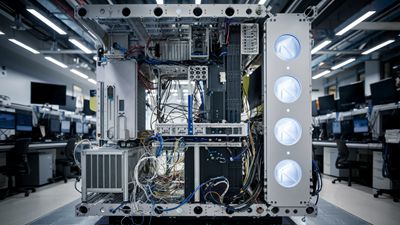Super Micro Computer’s 10-for-1 Stock Split: What It Means Amid Mixed Q4 Results
Key Takeaways
- Super Micro Computer (SMCI) announced a 10-for-1 stock split to make shares more accessible to smaller investors.
- Despite a significant revenue increase, SMCI’s Q4 earnings missed analyst expectations due to rising costs and margin pressures.
- Analysts have mixed views on SMCI, with some downgrading their price targets due to margin concerns.
- Compared to other AI chip stocks like Nvidia, SMCI offers higher projected growth but faces challenges in maintaining profit margins.
- The stock split could enhance liquidity and investor interest, but the company’s future performance will hinge on its ability to manage costs and sustain growth.
Historical Context and Recent Performance
Super Micro Computer has been a standout performer in the AI hardware market, with its stock price surging over 500% in the past year. The company’s fiscal Q4 2024 earnings report revealed a 109% year-over-year increase in revenue, reaching $14.9 billion. However, net income was $353 million, or $5.51 per share, falling short of analysts’ projections due to rising costs that affected profit margins. Gross margins dropped to 11.2% from 17% a year ago, raising concerns among investors and analysts.
Analysts’ Views on SMCI
Analysts have mixed opinions on SMCI following its Q4 earnings report and stock split announcement. Some have downgraded their price targets due to margin concerns. For instance, Bank of America lowered its price target from $1,090 to $700 and changed its rating from “buy” to “neutral.” Similarly, Barclays and Goldman Sachs also reduced their price targets, citing competitive pricing pressures and rising costs.
Conversely, some analysts remain bullish on SMCI’s long-term prospects. Rosenblatt Securities, for example, maintained a positive outlook, referring to SMCI as the “Switzerland of AI” due to its strategic positioning and partnerships with major chipmakers like Nvidia, AMD, and Intel. They believe that SMCI’s investments in liquid cooling technology and AI infrastructure will drive future growth.
Comparison with Other AI Chip Stocks
When compared to other AI chip stocks, SMCI presents a unique investment opportunity. Nvidia (NVDA), a leading player in the AI chip market, has also experienced significant growth, with its stock price increasing by over 2500% in the past five years. However, Nvidia’s higher valuation and intense competition from companies like Intel and AMD pose challenges.
SMCI, on the other hand, offers higher projected earnings growth. Analysts forecast an average annual earnings growth of around 62% for SMCI over the next five years, compared to Nvidia’s 46%. Additionally, SMCI’s lower valuation makes it an attractive option for growth-oriented investors. While Nvidia trades at a forward P/E ratio of 46, SMCI’s forward P/E ratio is just 14, indicating a lower valuation relative to its growth potential.
Strategic Considerations for Investors
For individual investors, SMCI’s 10-for-1 stock split could enhance liquidity and make the stock more accessible. Stock splits often signal management’s confidence in the company’s future prospects and can attract a broader investor base. However, the split does not change the company’s fundamental value, and investors should consider the underlying financial performance and growth potential.
SMCI’s strong revenue growth and strategic investments in AI infrastructure position it well for future growth. The company’s partnerships with major chipmakers and its focus on innovative technologies like direct liquid cooling (DLC) are expected to drive demand for its products. However, the significant drop in gross margins and rising costs are key risks that investors should monitor closely.
Future Outlook and Projections
Looking ahead, SMCI has provided a robust revenue forecast for fiscal 2025, projecting revenues between $26 billion and $30 billion, significantly above analyst estimates. The company aims to improve margins through strategic investments and operational efficiencies. Management’s goal is to achieve long-term gross margins of 14% to 17%, which would alleviate some of the current margin pressures.
The AI hardware market is expected to continue growing, driven by increasing demand for AI-enabled data centers and enterprise AI systems. SMCI’s ability to capitalize on this growth will depend on its execution of strategic initiatives and its ability to manage costs effectively.
Conclusion
Super Micro Computer’s 10-for-1 stock split is a strategic move aimed at making its shares more accessible to a broader range of investors. Despite mixed Q4 earnings results, the company’s strong revenue growth and strategic positioning in the AI market offer significant long-term potential. However, margin pressures and rising costs are key challenges that need to be addressed.
For individual investors, SMCI presents a compelling growth opportunity, particularly for those focused on capital appreciation. The stock split could enhance liquidity and investor interest, but the company’s future performance will hinge on its ability to manage costs and sustain growth. As the AI hardware market continues to evolve, SMCI’s strategic investments and partnerships will be critical in driving its success.
Investors should keep a close eye on SMCI’s financial performance and market dynamics, considering both the opportunities and risks associated with this high-growth AI stock.


